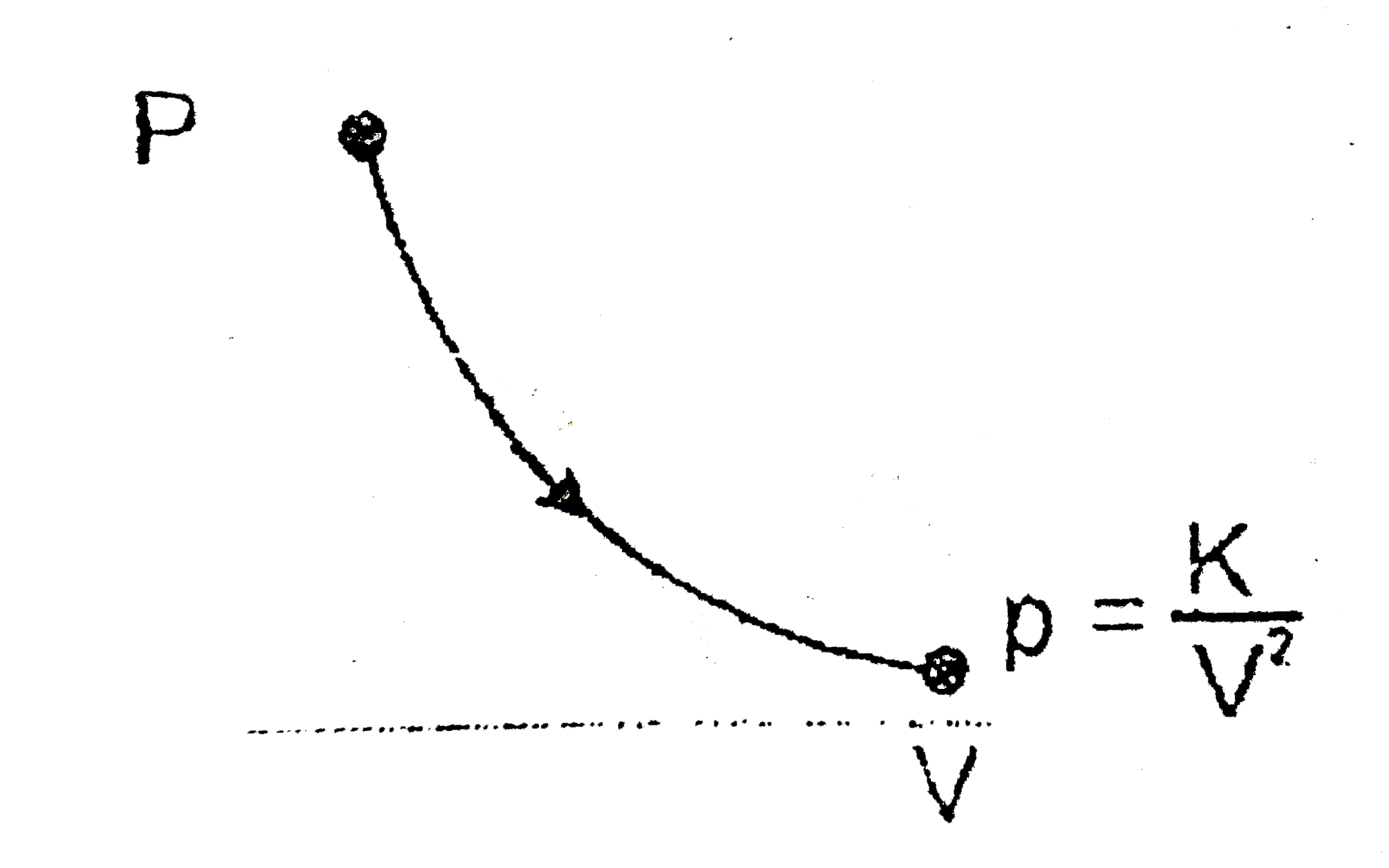A gas undergoes a process such that p∝1T. If the molar heat capacity for this process is C=33.24J/mol−K, find the degree of freedom of the molecules of the gas.
The correct Answer is:D
To solve the problem step by step, we will follow the reasoning provided in the video transcript.
Step 1: Understand the relationship between pressure and temperature
We are given that pressure P is inversely proportional to temperature T. This can be expressed mathematically as:
P∝1T⇒P⋅T=constant
Step 2: Relate the process to the ideal gas law
Using the ideal gas law, we can express temperature T in terms of pressure P and volume V:
PV=nRT⇒T=PVnR
Substituting this into our earlier relationship gives:
P⋅PVnR=constant
This simplifies to:
P2V=constant
Step 3: Express the relationship in terms of a power
From P2V=constant, we can express this as:
PV1/2=constant
This indicates that x=12 in the general form PVx=constant.
Step 4: Use the formula for molar heat capacity
The molar heat capacity C for a process described by PVx=constant is given by:
C=CV+R1−x
Where CV is the molar heat capacity at constant volume and R is the ideal gas constant.
Step 5: Substitute the known values
We know C=33.24J/mol-K and R=8.31J/mol-K. Substituting x=12 into the equation gives:
33.24=CV+8.311−12
This simplifies to:
33.24=CV+8.3112=CV+16.62
Thus, we can solve for CV:
CV=33.24−16.62=16.62J/mol-K
Step 6: Relate CV to the degree of freedom
The relationship between the heat capacity at constant volume and the degree of freedom f is given by:
CV=f2R
Substituting CV=16.62 and R=8.31:
16.62=f2⋅8.31
Solving for f:
f=16.62⋅28.31=4
Final Answer
The degree of freedom of the molecules of the gas is f=4.
---
We are given that pressure P is inversely proportional to temperature T. This can be expressed mathematically as:
P∝1T⇒P⋅T=constant
Using the ideal gas law, we can express temperature T in terms of pressure P and volume V:
PV=nRT⇒T=PVnR
Substituting this into our earlier relationship gives:
P⋅PVnR=constant
This simplifies to:
P2V=constant
From P2V=constant, we can express this as:
PV1/2=constant
This indicates that x=12 in the general form PVx=constant.
The molar heat capacity C for a process described by PVx=constant is given by:
C=CV+R1−x
Where CV is the molar heat capacity at constant volume and R is the ideal gas constant.
We know C=33.24J/mol-K and R=8.31J/mol-K. Substituting x=12 into the equation gives:
33.24=CV+8.311−12
This simplifies to:
33.24=CV+8.3112=CV+16.62
Thus, we can solve for CV:
CV=33.24−16.62=16.62J/mol-K
The relationship between the heat capacity at constant volume and the degree of freedom f is given by:
CV=f2R
Substituting CV=16.62 and R=8.31:
16.62=f2⋅8.31
Solving for f:
f=16.62⋅28.31=4
The degree of freedom of the molecules of the gas is f=4.
Topper's Solved these Questions
- LAWS OF THERMODYNAMICSBOOK - DC PANDEY ENGLISHCHAPTER - LAWS OF THERMODYNAMICSEXERCISE - Exercise 21.1
1 Videos
- LAWS OF THERMODYNAMICSBOOK - DC PANDEY ENGLISHCHAPTER - LAWS OF THERMODYNAMICSEXERCISE - Exercise 21.2
7 Videos
- LAWS OF THERMODYNAMICSBOOK - DC PANDEY ENGLISHCHAPTER - LAWS OF THERMODYNAMICSEXERCISE - Example Type 3
1 Videos
- LAWS OF MOTIONBOOK - DC PANDEY ENGLISHCHAPTER - LAWS OF MOTIONEXERCISE - Medical entrances gallery
39 Videos
- MAGNETIC EFFECT OF CURRENT AND MAGNETISMBOOK - DC PANDEY ENGLISHCHAPTER - MAGNETIC EFFECT OF CURRENT AND MAGNETISMEXERCISE - Integer type Questions
10 Videos
Similar Questions
Knowledge Check
A gas has molar heat capacity C=37.55Jmole−1K−1, in the process PT = constant, find the number of degree of freedom of the molecules of the gas.
A6B3C1D5
Ideal mono-atomic gas is taken through process such that dQ = 3dU. The molar heat capacity for process is:
View SolutionThe molar heat capacity for a gas at constant T and P is
View SolutionA certain ideal gas undergoes a polytropic process PVn = constant such that the molar specific heat during the process is negative. If the ratio of the specific heats of the gas be γ, then the range of values of n will be
View SolutionA certain ideal gas undergoes a polytropic process PVn = constant such that the molar specific heat during the process is negative. If the ratio of the specific heats of the gas be γ, then the range of values of n will be
View SolutionIf γ be the ratio of specific heats (Cp&Cv) for a perfect gas. Find the number of degrees of freedom of a molecules of the gas?
View SolutionThe molar heat capacity for the process shown in fig. is

View SolutionAn ideal diatomic gas with CV=5R2 occupies a volume V1 at a pressure P1. The gas undergoes a process in which the pressure is proportional to the volume. At the end of the process the rms speed of the gas molecules has doubled from its initial value.
The molar heat capacity of the gas in the given process is
View Solution
